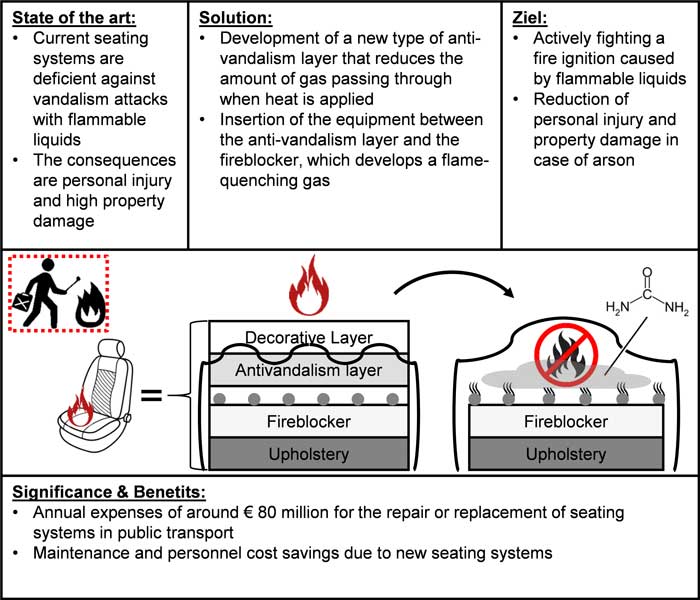
FireTrap – Development of cut and fire-resistant seating systems
Current seat systems have no chance against vandalism attacks using flammable liquids.
Modern seating systems in publicly accessible areas are required to be flame-retardant. However, the concepts available on the market do not actively control the flames.
Issue
By spreading a flammable liquid on the surface of the seat, the flames can reach the core of the seat and thus the upholstery below, leading to a devastating fire in the passenger compartment. This is why current seat systems have no chance against vandalism attacks using flammable liquids.
Aim and approach
The aim of the project is to develop a newly designed passenger seating system for the public sector that is not only cut-resistant and flame-retardant, but also actively combats a fire outbrake, so that the resulting fire is automatically extinguished without external influences. The resistance of seating systems to flammable liquid substances should also be increased by providing excellent cut resistance. This prevents the fire from spreading in the passenger compartment, prevents the entire vehicle from being destroyed and minimizes the risk to the passengers. The focus here is on preventing fires caused by flammable liquids such as petrol and diesel fuel or paint and varnish thinners. The application should not be limited to passenger seats for public transportation. It can be extended to other seating systems in the public sector (For eg; cinema and theater seats).
Solution
To achieve the project goals, a new type of textile is being developed that has the desired functionalities in combination with an underlying mechanism. To this end, yarns, fabrics and energy-consuming substances (such as urea and similar gas-generating substances) for flame containment are being newly developed in the project. The functionality of the individual components is verified by manufacturing demonstrators of seating systems and subsequent fire tests. The first step at the ITA is to develop yarns that exploit the cut resistance and fire resistance of the glass fibres without causing skin irritation. The development of a yarn structure consisting of multifilaments in the yarn core and staple fibres in the cover is carried out using an alternative spinning technology, friction spinning. The project’s approach is illustrated in Figure 1.
Economic significance & benefits
Deutsche Bahn records more than 25 cases of vandalism every single day. In 2004, 190 members of the Association of German Transport Companies calculated the cost of repairing damage caused by vandalism at around € 53 million, of which around € 31.5 million can be attributed to repairing damage to the vehicles. The repair or replacement of seats accounted for around € 7 million. This does not include damage caused by vandalism in public facilities. There are currently around 75,500 buses and coaches registered in Germany. A bus with an average of 40 passenger seats and one square metre of fabric per passenger seat results in a quantity of approx. 3,020,000 m² of seat fabric for Germany alone. This corresponds to approx 420 soccer fields, which can be substituted with the new innovation. In addition, there are other potential areas of application such as cinemas, theaters or other upholstered and public seating areas.
Acknowledgement
The ZIM project FireTrap is funded by the Federal Ministry for Economic Affairs and Climate Action as part of the Central Innovation Program for SMEs (ZIM). We would like to thank the Federal Ministry for Economic Affairs and Climate Action for funding our research project.
About the author:
Thomas Gries is a Professor at RWTH Aachen University and Seyit Halaç is a Researtch Associate- Staple Fibre Technlogies at RWTH Aachen University.



